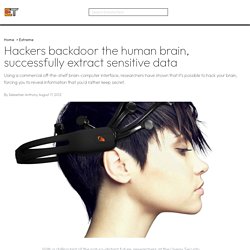Zoom
Trash

Immersive Cocoon // Step Into The Future. Tube-Shaped Scaffold May Help Nerve Cells Connect to Prosthetics. New implant allows the blind to stream Braille directly onto their retinas. Man in coma uses his thoughts to tell doctors, 'I'm not in pain' Brainwaves. Watson. IBM's Watson supercomputer destroys all humans in Jeopardy. BrainPort® V100. The BrainPort V100 is a non-surgical assistive device intended for orientation, mobility, object identification, and spot reading by individuals who are blind with no useful vision.

It translates digital information from a video camera into gentle electrical stimulation patterns on the surface of the tongue. Users feel moving bubble-like patterns on their tongue which they learn to interpret as the shape, size, location and motion of objects in their environment. The BrainPort V100 is intended to augment rather than replace other assistive technologies such as the white cane or dog guide. The BrainPort V100 device is an Investigational Device and its use remains limited by U.S. Federal Law to investigational uses only. Spectre footnotes. From the archive, originally posted by: [ spectre ] Warriors of the future will ‘taste’ battlefield / April 25, 2006 PENSACOLA, Florida (AP) — In their quest to create the super warrior of the future, some military researchers aren’t focusing on organs like muscles or hearts.

They’re looking at tongues. By routing signals from helmet-mounted cameras, sonar and other equipment through the tongue to the brain, they hope to give elite soldiers superhuman senses similar to owls, snakes and fish. Researchers at the Florida Institute for Human and Machine Cognition envision their work giving Army Rangers 360-degree unobstructed vision at night and allowing Navy SEALs to sense sonar in their heads while maintaining normal vision underwater — turning sci-fi into reality. The device, known as “Brain Port,” was pioneered more than 30 years ago by Dr. Brainport Vision Device helps a blind man "see" Paralyzed woman controls robotic arm, sips coffee. Performing even a simple movement is a rather complicated process.

First, the brain has to signal its intent to perform an action, which then gets translated into the specific motions that are required to achieve that intention. Those motions require a series of muscle contractions; the signals for these need to be sent out of the brain, through the spinal cord, and to the appropriate destination. For most people who suffer from paralysis, it's really these later steps that are affected—most of the setup can still go on in the brain, but damage keeps the signals from making their way to the muscles. If there were a way to eavesdrop on the brain, it might be possible to identify an individual's intent and translate that into some form of useful action. This may sound like science fiction, but significant progress has been made in the area.
Now, we've taken the next big step. A bioinformatics platform for crowd-sourced brain research. Emotiv Insight A wireless headset that records your brainwaves and translates them into meaningful data you can understand What you can do with a little Insight...

Optimize your brain fitness and performance. Measure your own or your family's cognitive health and wellbeing Create amazing applications with our APIs and analysis tools. Future360 - Tan Le, Co-Founder and CEO, Emotive Life Sciences. Tan Le: A headset that reads your brainwaves. Emotiv Lifescience by Nick Wasko on Prezi. Hackers backdoor the human brain, successfully extract sensitive data. With a chilling hint of the not-so-distant future, researchers at the Usenix Security conference have demonstrated a zero-day vulnerability in your brain.

Using a commercial off-the-shelf brain-computer interface, the researchers have shown that it’s possible to hack your brain, forcing you to reveal information that you’d rather keep secret. As we’ve covered in the past, a brain-computer interface is a two-part device: There’s the hardware — which is usually a headset (an EEG; an electroencephalograph) with sensors that rest on your scalp — and software, which processes your brain activity and tries to work out what you’re trying to do (turn left, double click, open box, etc.) BCIs are generally used in a medical setting with very expensive equipment, but in the last few years cheaper, commercial offerings have emerged.
For $200-300, you can buy an Emotiv (pictured above) or Neurosky BCI, go through a short training process, and begin mind controlling your computer. Biotech Breakthrough: Monkeys can feel virtual objects using a brain implant. As long as they figure out which areas to stimulate those problems can be solved with neuro-optics.

It works by inserting a gene into the target neurons that makes them fire when exposed to a specific frequency of light. So instead of having to physically insert pieces of metal into the brain they place small laser diodes on the outside of the brain and fire them through the intervening tissue without actually harming it. Since no parts of the device is in direct contact with the brain it can be replaced, or upgraded, without worrying about permanently damage to the brain itself. Someone is already well underway with a "brain pacemaker" for schizophrenics that utilities the principle.
Been successfully done in animals, but obviously anything that requires genetic engineering of neurons obviously have to make their way through a couple miles of red tape before they can even be tried on humans, so they have still barely entered human testing afaik. Brain-to-brain interfaces have arrived, and they are absolutely mindblowing. I am almost speechless at this!

This is astounding! This is truly astounding! If it can be scaled up to the human level, if it can be done without what is sure to be hugely invasive brain surgery, this might revolutionize everything in ways we barely guess at. For example, imagine a trained and skilled pianist, guiding students through piano lessons by guiding their motor impulses though this system. The connection could between the brains could be made slowly and subtly more noisy forcing the student brains to fill in the details themselves, thus learning the skills and motor actions required. This is truly incredible. Still even at only 66% accuracy it's remarkable. G.Tec Brain-Computer Interface.